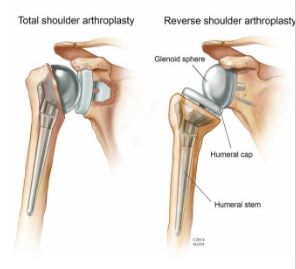Shoulder Replacement Surgery
 For patients who have severe shoulder arthritis and pain despite conservative care, shoulder replacement, also known as arthroplasty, may be an option. Shoulder arthroplasty involves replacing the worn surfaces of the humeral head (ball) and glenoid (socket) with metal and plastic implants.
For patients who have severe shoulder arthritis and pain despite conservative care, shoulder replacement, also known as arthroplasty, may be an option. Shoulder arthroplasty involves replacing the worn surfaces of the humeral head (ball) and glenoid (socket) with metal and plastic implants.
Shoulder arthroplasty comes in two types: anatomic replacement and reverse replacement. An anatomic shoulder replacement involves replacing the humeral head and glenoid with metal ball and socket implants that match the normal anatomy. This requires an intact rotator cuff to allow for the shoulder replacement to function properly.
In those who do not have an intact rotator cuff, a reverse shoulder replacement can be performed. For this replacement, the metal ball and socket implants are reversed to create a mechanical advantage so that the shoulder replacement can function without a rotator cuff. Reverse shoulder replacements utilizes other larger shoulder muscles, such as the deltoid, to restore shoulder function.
Both types of shoulder replacement surgery can help restore the motion around the shoulder and are very good for relieving pain from an arthritic shoulder. After a full period of rehabilitation, patients generally sleep better and have better function in their daily activities and non-contact recreational activities. However, shoulder replacement cannot make the joint as good as it was before the arthritis started.
 Shoulder replacement is considered an elective surgery. It should be scheduled when you are in optimal health and have time and help available for the rehabilitation period. In some cases the pain and stiffness will stabilize at a level that is tolerable for you. When this happens, shoulder replacement can generally be delayed without compromising a future surgery.
Shoulder replacement is considered an elective surgery. It should be scheduled when you are in optimal health and have time and help available for the rehabilitation period. In some cases the pain and stiffness will stabilize at a level that is tolerable for you. When this happens, shoulder replacement can generally be delayed without compromising a future surgery.
Recovery After Surgery
Shoulder replacement is an inpatient surgery that requires an incision on the front of your shoulder and involves cutting tendons, muscle, and bone. Most patients stay in the hospital 1-3 days after surgery until their pain is controlled and they are functioning well enough to go home. Physical therapy and your home exercise program are essential parts of your surgical treatment. The physical therapists will work with you throughout the recovery period, starting the day after your surgery.
Most patients go home after shoulder replacement but generally need help with daily activities, shopping, and driving for about six weeks after surgery. In general, patients feel significantly better by about six weeks after surgery but often notice improvements in strength and function up to a year after surgery.
The risks associated with shoulder replacement are generally low, but there are some significant complications that can occur:
- Continued pain or stiffness due to scarring in the shoulder
- Pain due to irritation or tearing of rotator cuff
- Fracture around the prosthesis
- Dislocation
- Infection (all patients receive antibiotics at the time of surgery to decrease this risk)
- Loosening or wear of the metal or plastic
A more general complication of surgery can also occur. These include:
- Deep venous thrombosis (aka “blood clot” or DVT)
- Nerve injury (associated with numbness, weakness, or paralysis)
- Vascular injury
- Complications associated with the anesthesia
